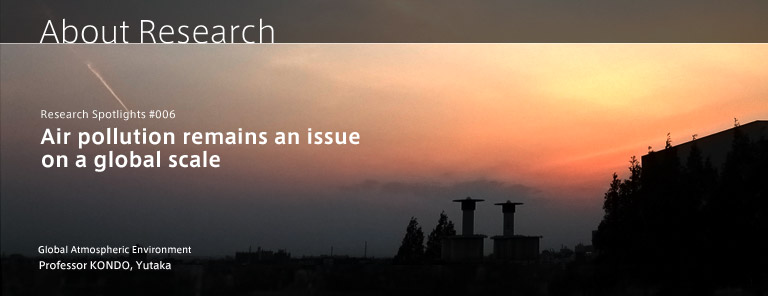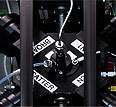
Much has been made of the many health effects arising from air pollution in China. It has become a matter of pressing concern for China to improve its air quality before the Beijing Olympics. However, this is not something we can just pass off as someone else's problem. Recent studies have clearly shown that the effects of air pollution are not confined to only China or neighboring countries but are of a global magnitude. The use of massive amounts of fossil fuels generate airborne pollutants such as nitrogen oxide (NOx) and fine particles (aerosol). In our research in the Kondo Lab we pay particular attention to ozone (O3) and fine particles, which are formed through photochemical reactions with nitrogen oxide and so forth.
The impact of ozone
Ozone causes a number of problems, such as inhibiting plant growth, damaging forests, and reducing crop yields. There is concern that if ozone impacts vegetation in China, this will cause reductions in the production of rice, soybeans and vegetable crops, along with changes in the food supplies. Furthermore, as ozone has strong oxidizing potential, this may also lead to adverse affects on human respiratory organs. The Ministry of the Environment has pointed out the potential for alpine forests along the Sea of Japan to die due to ozone drifting over from the Asian continent. It is also known that, once ozone reaches the upper atmosphere through convective activity, it operates as a greenhouse gas.

-
The Kondo Lab focuses its research activities on illuminating the causes of global ozone distribution and how it changes, centering mainly on Japan and the East Asian region. For this purpose, we conduct ground-based and aircraft observations using RCAST's atmospheric measurement technology and analyze satellite data together with the 3-dimensional chemical transport model. In this way we aim to contribute to reliable future predictions of changes in air pollution.
Fine particles generated by diesel engines
Fine particles refers to airborne particles which range in size from several nm (nanometers) to 100μm (micrometers) in diameter. It is believed that large quantities of fine particles are emitted into the air by anthropogenic activities. For example, particularly hazardous among particles emitted into the air by incomplete combustion of diesel engines is what is called black carbon aerosol. Fine particles that we breathe into our bodies on a daily basis are eventually deposited in the alveoli, which then causes health hazards. In addition, just as the name black carbon indicates, as this aerosol is black in color it has the effect of absorbing sunlight, heating the atmosphere, and accelerating global warming.
Environmental measures and observational data

-
The inception of regulations on diesel-powered vehicles in Tokyo in October, 2003 is still fresh on our minds, but the fact of the matter is that observational data on the effects of these regulations is still sorely lacking. The Kondo Lab is engaged in the long-term observation of black carbon and its tracers (compounds marked for the purpose of identifying its sources) and carrying out research together with various localities oriented towards establishing a method for assessing the effects of diesel regulations. Although implementing environmental measures is important, it is also extremely essential to resolutely follow-up on these measures to determine whether they are having an effect. Based on these results, we began to measure aerosol emissions in Beijing with a high degree of precision from November, 2005 and it is expected that these data will contribute to effective measures for improving air quality in Beijing.
Interviewer:Tomohisa Sumita
*Title: Photograph of an instrument on the roof of Building No.56 for measuring the intensity of radiation from the sun.
(December 21, 2005)

